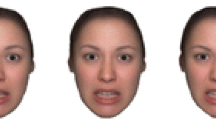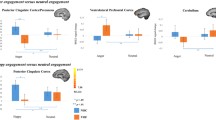Abstract
Aggressive behavior is assumed to be associated with certain patterns of social information processing. While some theories link aggression to a tendency to interpret ambiguous stimuli as hostile (i.e., enhanced sensitivity to anger), others assume an insufficient ability to perceive emotional expressions, particularly fear. Despite compelling evidence to support both theories, no previous study has directly investigated the predictions made by these two accounts in aggressive populations. The aim of the current study was to test processing patterns for angry and fearful facial expressions in violent offenders (VOs) and healthy controls (CTLs) and their association with self-reported aggression and psychopathy scores. In Experiment 1, we assessed perceptual sensitivity to neutral-emotional (angry, fearful, happy) blends in a task which did not require categorization, but an indication whether the stimulus is neutral or emotional. In Experiment 2, we assessed categorization performance for ambiguous fearful-happy and angry-happy blends. No group differences were revealed in Experiment 1, while Experiment 2 indicated a deficit in the categorization of ambiguous fearful blends in the VO group. Importantly, this deficit was associated with both self-reported psychopathy and aggression in the VO, but not the CTL group. The current study provides evidence for a deficient categorization of fearful expressions and its association with self-reported aggression and psychopathy in VOs, but no support for heightened sensitivity to anger. Furthermore, the current findings indicate that the deficit is tied to categorization but not detection stages of social information processing.



Similar content being viewed by others
References
Crick NR, Dodge KA (1994) A review and reformulation of social information-processing mechanisms in children’s social adjustment. Psychol Bull 115:74–101
Crick NR, Dodge KA (1996) Social information-processing mechanisms in reactive and proactive aggression. Child Dev 67:993–1002
Oostermeijer S, Nieuwenhuijzen M, van de Ven P, Popma A, Jansen L (2016) Social information processing problems related to reactive and proactive aggression of adolescents in residential treatment. Pers Indiv Differ 90:54–60
Dodge KA (2006) Translational science in action: hostile attributional style and the development of aggressive behavior problems. Dev Psychopathol 18:791–814
Nasby W, Hayden B, DePaulo BM (1980) Attributional bias among aggressive boys to interpret unambiguous social stimuli as displays of hostility. J Abnorm Psychol 89:459–468
De Castro BO, Veerman JW, Koops W, Bosch JD, Monshouwer HJ (2002) Hostile attribution of intent and aggressive behavior: a meta-analysis. Child Dev 73:916–934
Wilkowski BM, Robinson MD (2012) When aggressive individuals see the world more accurately the case of perceptual sensitivity to subtle facial expressions of anger. Pers Soc Psychol B 38:540–553
Mellentin AI, Dervisevic A, Stenager E, Pilegaard M, Kirk U (2015) Seeing enemies? A systematic review of anger bias in the perception of facial expressions among anger-prone and aggressive populations. Aggress Violent Behav 25:373–383
Burt SA, Mikolajewski AJ, Larson CL (2009) Do aggression and rule-breaking have different interpersonal correlates? A study of antisocial behavior subtypes, negative affect, and hostile perceptions of others. Aggress Behav 35:453–461
Hall CW (2006) Self-reported aggression and the perception of anger in facial expression photos. J Psychol 140:255–267
Knyazev GG, Bocharov AV, Slobodskoj-Plusnin JY (2009) Hostility and gender related differences in oscillatory responses to emotional facial expressions. Aggress Behav 35:502–513
Hoaken PNS, Allaby DB, Earle J (2007) Executive cognitive functioning and the recognition of facial expressions of emotion in incarcerated violent offenders, non-violent offenders, and controls. Aggress Behav 33:412–421
Schönenberg M, Jusyte A (2014) Investigation of the hostile attribution bias toward ambiguous facial cues in antisocial violent offenders. Eur Arch Psychiatry Clin Neurosci 264:61–69
Penton-Voak IS, Thomas J, Gage SH, McMurran M, McDonald S, Munafò MR (2013) Increasing recognition of happiness in ambiguous facial expressions reduces anger and aggressive behavior. Psychol Sci 24:688–697
Blair R (1995) A cognitive developmental approach to morality: investigating the psychopath. Cognition 57:1–29
Blair R (2001) Neurocognitive models of aggression, the antisocial personality disorders, and psychopathy. J Neurol Neurosurg Psychiatry 71:727–731
Marsh AA, Blair R (2008) Deficits in facial affect recognition among antisocial populations: a meta-analysis. Neurosci Biobehav Rev 32:454–465
Blair R, Mitchell D, Peschardt K, Colledge E, Leonard R, Shine J, Murret L, Perrett D (2004) Reduced sensitivity to others’ fearful expressions in psychopathic individuals. Pers Indiv Differ 37:1111–1122
Eisenbarth H, Alpers GW, Segrè D, Calogero A, Angrilli A (2008) Categorization and evaluation of emotional faces in psychopathic women. Psychiatry Res 159:189–195
Hastings ME, Tangney JP, Stuewig J (2008) Psychopathy and identification of facial expressions of emotion. Pers Indiv Differ 44:1474–1483
Kosson DS, Suchy Y, Mayer AR, Libby J (2002) Facial affect recognition in criminal psychopaths. Emotion 2:398
Montagne B, van Honk J, Kessels RP, Frigerio E, Burt M, van Zandvoort MJ, de Haan EH (2005) Reduced efficiency in recognising fear in subjects scoring high on psychopathic personality characteristics. Pers Indiv Differ 38:5–11
Dolan M, Fullam R (2006) Face affect recognition deficits in personality-disordered offenders: association with psychopathy. Psychol Med 36:1563–1569
Viding E, Sebastian CL, Dadds MR, Lockwood PL, Cecil CA, De Brito SA, McCrory EJ (2012) Amygdala response to preattentive masked fear in children with conduct problems: the role of callous-unemotional traits. Am J Psychiatry 169:1109–1116
White SF, Williams WC, Brislin SJ, Sinclair S, Blair KS, Fowler KA, Pine D, Pope K, Blair RJ (2012) Reduced activity within the dorsal endogenous orienting of attention network to fearful expressions in youth with disruptive behavior disorders and psychopathic traits. Dev Psychopathol 24:1105–1116
Sato W, Uono S, Matsuura N, Toichi M (2009) Misrecognition of facial expressions in delinquents. Child Adol Psychiatry Ment Health 3:27–34
Schönenberg M, Christian S, Gaußer A-K, Mayer SV, Hautzinger M, Jusyte A (2014) Addressing perceptual insensitivity to facial affect in violent offenders: first evidence for the efficacy of a novel implicit training approach. Psychol Med 44:1043–1052
Schönenberg M, Louis K, Mayer S, Jusyte A (2013) Impaired identification of threat-related social information in male delinquents with antisocial personality disorder. J Pers Disord 27:496
Schönenberg M, Mayer SV, Christian S, Louis K, Jusyte A (2015) Facial affect recognition in violent and nonviolent antisocial behavior subtypes. J Pers Disord. doi:10.1521/pedi_2015_29_217
Dadds MR, El Masry Y, Wimalaweera S, Guastella AJ (2008) Reduced eye gaze explains “fear blindness” in childhood psychopathic traits. J Am Acad Child Psychiatry 47:455–463
Jusyte A, Mayer SV, Künzel E, Hautzinger M, Schönenberg M (2015) Unemotional traits predict early processing deficit for fearful expressions in young violent offenders: an investigation using continuous flash suppression. Psychol Med 45:285–297
Sylvers PD, Brennan PA, Lilienfeld SO (2011) Psychopathic traits and preattentive threat processing in children a novel test of the fearlessness hypothesis. Psychol Sci 22:1280–1287
Leist T, Dadds MR (2009) Adolescents’ ability to read different emotional faces relates to their history of maltreatment and type of psychopathology. Clin Child Psychol Psychiatry 14:237–250
Fairchild G, Stobbe Y, Van Goozen SH, Calder AJ, Goodyer IM (2010) Facial expression recognition, fear conditioning, and startle modulation in female subjects with conduct disorder. Biol Psychiatry 68:272–279
Stevens D, Charman T, Blair R (2001) Recognition of emotion in facial expressions and vocal tones in children with psychopathic tendencies. J Genet Psychol 162:201–211
Best M, Williams JM, Coccaro EF (2002) Evidence for a dysfunctional prefrontal circuit in patients with an impulsive aggressive disorder. Proc Natl Acad Sci 99:8448–8453
Schwenck C, Gensthaler A, Romanos M, Freitag CM, Schneider W, Taurines R (2014) Emotion recognition in girls with conduct problems. Eur Child Adoles Psychiatry 23:13–22
Buss AH, Perry M (1992) The aggression questionnaire. J Pers Soc Psychol 63:452–459
Neumann CS, Schmitt DS, Carter R, Embley I, Hare RD (2012) Psychopathic traits in females and males across the globe. Behav Sci Law 30:557–574
Formann A, Piswanger K (1979) Wiener Matrizen-Test. Manual: Beltz Test Gesellschaft, Weinheim
Formann AK, Waldherr K, Piswanger K (2011) Wiener Matrizen-Test 2. Manual: Beltz Test GmbH, Göttingen
Langner O, Dotsch R, Bijlstra G, Wigboldus DHJ, Hawk ST, Van Knippenberg A (2010) Presentation and validation of the Radboud faces database. Cogn Emot 24:1377–1388
Dawel A, O’Kearney R, McKone E, Palermo R (2012) Not just fear and sadness: meta-analytic evidence of pervasive emotion recognition deficits for facial and vocal expressions in psychopathy. Neurosci Biobehav Rev 36:2288–2304
Wilson K, Juodis M, Porter S (2011) Fear and loathing in psychopaths: a meta-analytic investigation of the facial affect recognition deficit. Crim Justice Behav 38:659–668
Short RM, Sonuga-Barke EJ, Adams WJ, Fairchild G (2016) Does comorbid anxiety counteract emotion recognition deficits in conduct disorder? J Child Psychol Psychiatry 57:916–926
Blair R (2007) Empathic dysfunction in psychopathic individuals. In: Farrow TD, Woodruff PWR (eds) Empathy in mental illness. Cambridge University Press, Cambridge, pp 3–16
Burt SA (2012) How do we optimally conceptualize the heterogeneity within antisocial behavior? An argument for aggressive versus non-aggressive behavioral dimensions. Clin Psychol Rev 32:263–279
Frick PJ, White SF (2008) Research review: the importance of callous-unemotional traits for developmental models of aggressive and antisocial behavior. J Child Psychol Psychiatry 49:359–375
Pollak SD (2008) Mechanisms linking early experience and the emergence of emotions illustrations from the study of maltreated children. Curr Dir Psychol Sci 17:370–375
Pollak SD, Kistler DJ (2002) Early experience is associated with the development of categorical representations for facial expressions of emotion. Proc Natl Acad Sci 99:9072–9076
Pollak SD, Sinha P (2002) Effects of early experience on children’s recognition of facial displays of emotion. Dev Psychol 38:784–794
Schönenberg M, Schneidt A, Wiedemann E, Jusyte A (2015) Processing of dynamic affective information in adults with ADHD. J Atten Disord. doi:10.1177/1087054715577992
Stein T, Peelen MV (2015) Content-specific expectations enhance stimulus detectability by increasing perceptual sensitivity. J Exp Psychol 144:1089–1104
Sevgi M, Diaconescu AO, Tittgemeyer M, Schilbach L (2015) Social Bayes: using Bayesian modeling to study autistic trait-related differences in social cognition. Biol Psychiatry 80:112–119
Van den Stock J, Righart R, De Gelder B (2007) Body expressions influence recognition of emotions in the face and voice. Emotion 7:487–494
Lin P-I, Hsieh C-D, Juan C-H, Hossain MM, Erickson CA, Lee Y-H, Su M-C (2016) Predicting aggressive tendencies by visual attention bias associated with hostile emotions. PLoS ONE 11:e0149487
Blair R (2010) Neuroimaging of psychopathy and antisocial behavior: a targeted review. Curr Psychiatry Rep 12:76–82
Blair R (2007) The amygdala and ventromedial prefrontal cortex in morality and psychopathy. Trends Cogn Sci 11:387–392
Schilbach L (2016) Towards a second-person neuropsychiatry. Philos Trans R Soc B 371:20150081
Acknowledgments
The authors would like to thank Sandra Christian and Sarah Mayer for the support in data collection, and Ryan Dutton for language editing.
Funding
This research was funded by the LEAD Graduate School [GSC1028], a project of the Excellence Initiative of the German federal and state governments.
Author information
Authors and Affiliations
Corresponding author
Ethics declarations
Conflict of interest
The authors have no conflict to declare.
Rights and permissions
About this article
Cite this article
Jusyte, A., Schönenberg, M. Impaired social cognition in violent offenders: perceptual deficit or cognitive bias?. Eur Arch Psychiatry Clin Neurosci 267, 257–266 (2017). https://doi.org/10.1007/s00406-016-0727-0
Received:
Accepted:
Published:
Issue Date:
DOI: https://doi.org/10.1007/s00406-016-0727-0




